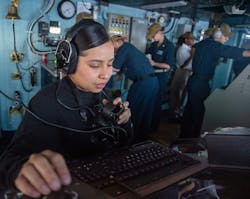Navy continues orders for software-defined surface-search radar to replenish surface warship sensors
Questions and answers:
- What is the purpose of the AN/SPS-73(V)18 Next Generation Surface Search Radar (NGSSR)? It is to replace older Navy radar systems, and improve navigation, situational awareness, and target detection in cluttered environments using advanced software-defined technology.
- Why is radar clutter a problem for surface-search systems? aIt reflects unwanted signals from the sea, weather, or man-made objects that can obscure real targets, and increases the risk of false readings or missed threats.
- How does the NGSSR improve over legacy systems like the AN/SPS-67 and BridgeMaster E? It uses a software-defined architecture to ease updates, reject clutter, extend range, improve performance in bad weather, and resist jamming.
WASHINGTON – U.S. Navy Surface warship experts are ordering new software-defined surface-search radar systems to replace existing radars that suffer from obsolescent technologies or an inability to meet current threats.
Officials of the Naval Sea Systems Command in Washington announced an $56 million order last week to the Ultra Electronics Ocean Systems segment in Braintree, Mass., for production and spare parts for the AN/SPS-73(V) Next Generation Surface Search Radar (NGSSR) systems.
Navigation and situational awareness are basic functions of all surface warships and these seemingly routine tasks have become more difficult as the ocean becomes increasingly complex with the proliferation of inexpensive solid-state radar, Navy officials say.
Ultra Electronics won a $13.7 million NGSSR order in August, and an $83.8 million NGSSR contract last December. In July 2020 Ultra won a $42.2 million order to acquire the first NGSSR production lot following a contract award for design and production of three qualification systems. In March 2019 Ultra Electronics won a $28 million contract to develop NGSSR qualification systems.
Dense surface traffic
Major shipping channels are jammed with ship and radio traffic as well as debris like floating transport containers. Even small fishing boat and pleasure craft operators today can afford navigation radar systems. Air traffic and land-based radar further crowd and confuse the radio spectrum.
To make matters worse, enemy ships, aircraft, and unmanned aerial vehicles (UAVs) can exploit this complex sensor picture to conduct surveillance or other operations undetected.
The AN/SPS-73(V)18 NGSSR uses of the latest digital technology and incorporates a software-based architecture at its core. NGSSR will have a suite of algorithms that extend, enhance, and optimize NGSSR's performance by exploiting the system's software-defined architecture.
Tell me more about the issue of clutter in surface-search radar ...
- Clutter in surface-search radar comes from unwanted echoes or signals that interfere with the radar’s ability to detect and track legitimate targets, such as ships, aircraft, or land-based objects. This clutter typically arises from various sources, including the sea surface, terrain, weather conditions, and man-made structures. It can obscure or confuse the radar’s true target detection capabilities, leading to false readings or degraded performance. Radar systems employ several techniques to minimize or eliminate the effects of clutter, such as clutter rejection algorithms; frequency modulation; adaptive clutter mapping; Doppler processing; polarization; antenna design; and filtering by time and space. Radar clutter rejection often involves signal processing, which may require fast processors and complex hardware, which can increase the cost and complexity of radar systems.
The NGSSR's receiver and exciter are implemented in software to the maximum extent possible, Navy officials say. The bulk of the non-processor hardware is for A/D and D/A conversion, except for ancillary equipment like power supplies. Its software-defined capabilities are expected to enhance maintainability by reducing radar-specific hardware.
Its software-defined architecture also could implement functionality never before considered for such relatively simple rotating radar, such as extending the radar’s range and navigation functions in bad weather; resisting enemy electronic warfare attempts to jam it; detecting UAVs, periscopes, floating debris, and floating mines; and improving collision avoidance in crowded waterways.
The new AN/SPS-73(V)18 NGSSR software-defined radar ultimately will replace all variants of the Navy's current AN/SPS-67, AN/SPS-73, BridgeMaster E series, and commercial-of-the-shelf radar systems.
Radar to be replaced
The AN/SPS-67 is a short-range, two-dimensional, surface-search and navigation radar system that provides surface and limited low-flyer detection and tracking. Older versions of the AN/SPS-73 are short-range, two-dimensional, surface search and navigation radar systems that provides contact range and bearing information, and helps determine own-ship position relative to nearby vessels and navigational hazards. The BridgeMaster E surface- search radar, meanwhile, provides navigation to commercial and military high speed vessels.
The AN/SPS-73(V)12 is installed on about 100 Navy ships like aircraft carriers, cruisers, destroyers, amphibious assault ships, and support ships. It was placed into caretaker Status in 2017 in preparation for its replacement by the AN/SPS-73(V)18 NGSSR. Thousands of BridgeMaster E marine radars, meanwhile, have been sold to more than 50 navies and coast guards worldwide as well as civilian customers. It replaced the Navy SPS-64 surface-search radar on Arleigh Burke-class destroyers in 2001.
On this order Ultra will do the work in Braintree, Mass.; Wake Forest, N.C.; and Chantilly, Va., and should be finished by August 2027. For more information contact Ultra Electronic Ocean Systems online at https://umaritime.com/radar-electronic-warfare/, or the Naval Sea Systems Command at www.navsea.navy.mil.
About the Author
John Keller
Editor-in-Chief
John Keller is the Editor-in-Chief, Military & Aerospace Electronics Magazine--provides extensive coverage and analysis of enabling electronics and optoelectronic technologies in military, space and commercial aviation applications. John has been a member of the Military & Aerospace Electronics staff since 1989 and chief editor since 1995.
